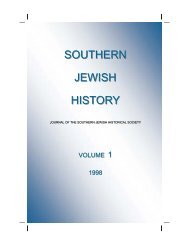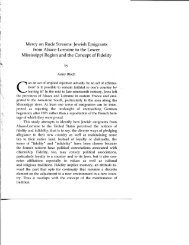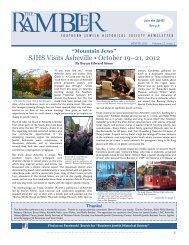A Shtetl Grew in Bessemer - Southern Jewish Historical Society
A Shtetl Grew in Bessemer - Southern Jewish Historical Society
A Shtetl Grew in Bessemer - Southern Jewish Historical Society
Create successful ePaper yourself
Turn your PDF publications into a flip-book with our unique Google optimized e-Paper software.
BARR/A SHTETL GREW IN BESSEMER 21<br />
believed her. But it wouldn’t bother my grandfather at all to<br />
watch us open our Christmas presents. The same th<strong>in</strong>g was true<br />
of Passover and Easter. We’d dye eggs—not us<strong>in</strong>g the dye that<br />
gentiles would use; <strong>in</strong>stead, Mother would use either coffee or<br />
tea, and so we’d have the ugliest eggs around. We’d also get<br />
Easter baskets with chocolate candy, but we couldn’t eat the<br />
candy until after Passover. 94<br />
Many <strong>Jewish</strong> merchants offered Christmas light displays<br />
dur<strong>in</strong>g the season <strong>in</strong> order to show good faith with gentile<br />
<strong>Bessemer</strong> friends and customers. But the greatest ironies were<br />
found at home. Arnold Lefkovits, whose family did have Christmas<br />
trees, recalls that his father Norman<br />
used to decorate our yard with lights on the bushes and shrubbery.<br />
And one time Daddy won the award for prettiest<br />
Christmas decorations <strong>in</strong> <strong>Bessemer</strong>. That’s hard to believe, but it<br />
happened. All blue lights he had on the shrubbery near the front<br />
of our house . . . Later on I thought of the irony of this. And<br />
though we had trees, there was no religious significance . . . we’d<br />
never have a star or any other religious decorations. . . . It was<br />
just the friendl<strong>in</strong>ess, good cheer, the joy of Santa Claus. And of<br />
course we’d all go to Temple Beth-El. I remember when I was<br />
little ask<strong>in</strong>g my Grandpa why we went to temple. He said, “It’s<br />
the custom, the custom.” 95<br />
In the early 1940s, Charles We<strong>in</strong>ste<strong>in</strong> was perform<strong>in</strong>g the<br />
duties of lay reader for temple services on a regular basis. 96 Soon<br />
after, however, reflect<strong>in</strong>g a refusal to compromise his religious<br />
pr<strong>in</strong>ciples any longer <strong>in</strong> that Beth-El did not hold services regularly<br />
enough, We<strong>in</strong>ste<strong>in</strong> began driv<strong>in</strong>g to Birm<strong>in</strong>gham to attend<br />
synagogue. He would spend the weekend with the K<strong>in</strong>dl<strong>in</strong>g or<br />
Mayer families, and after services he and Mr. Mayer discussed the<br />
Torah until Sunday afternoon when We<strong>in</strong>ste<strong>in</strong> returned to<br />
<strong>Bessemer</strong>. 97<br />
At this po<strong>in</strong>t, however, Levi Becker, along with other <strong>Jewish</strong><br />
residents, decided that to promote greater religious as well as social<br />
unity, Temple Beth-El needed a full-time rabbi. 98 And so <strong>in</strong><br />
1948, Rabbi Joseph S. Gall<strong>in</strong>ger was hired as the new religious







